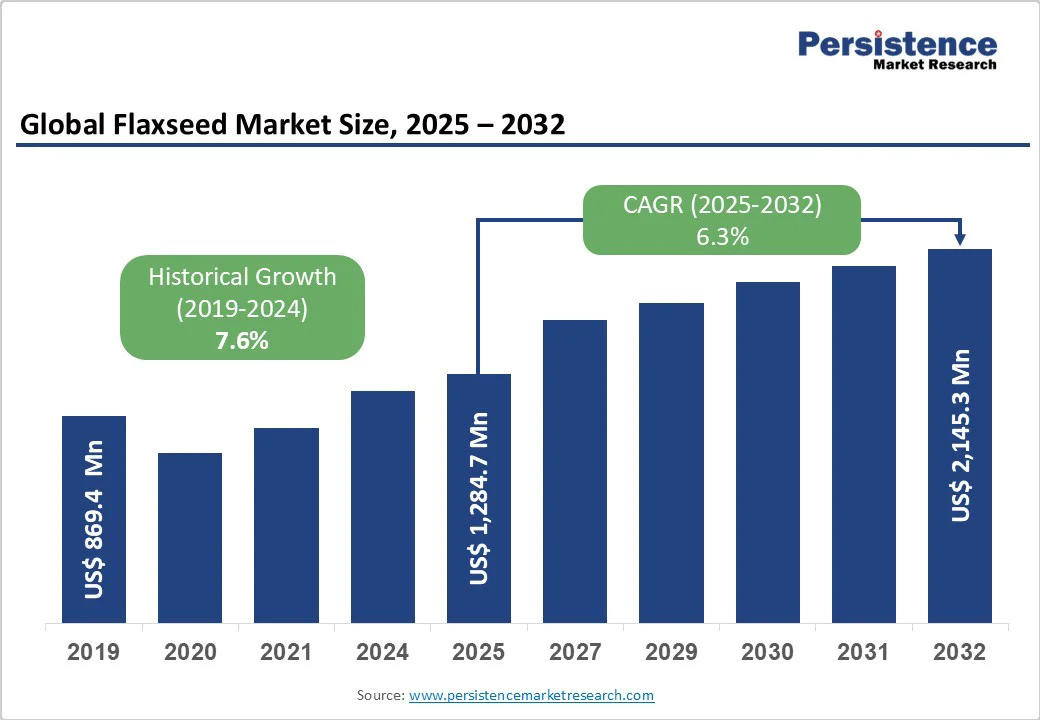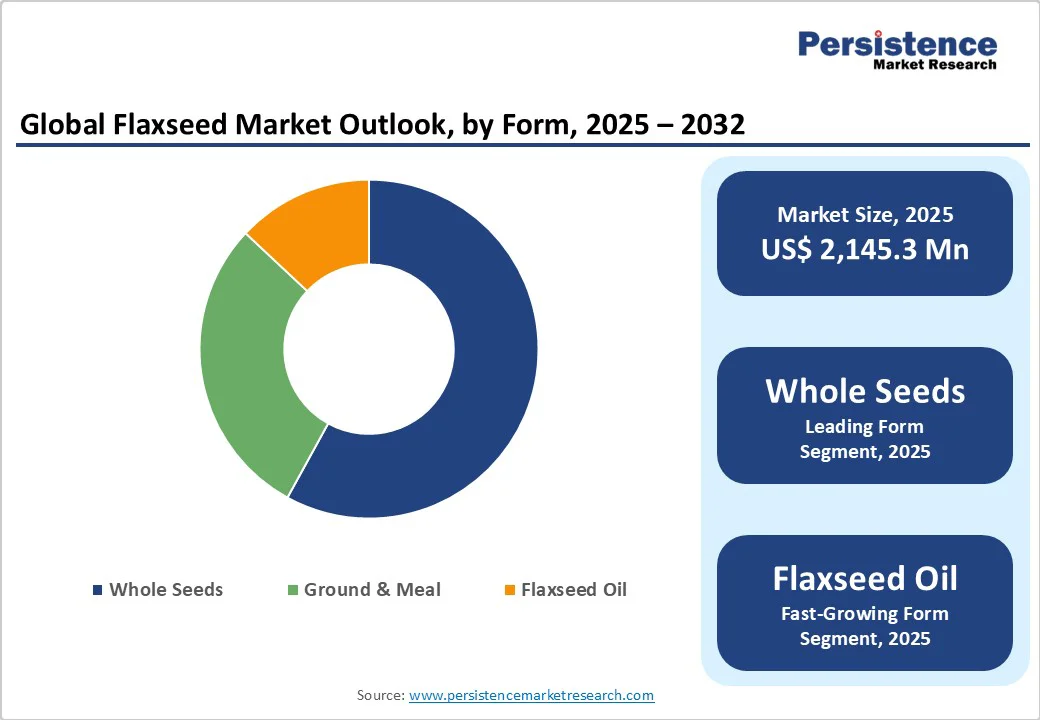ID: PMRREP10286| 356 Pages | 24 Oct 2025 | Format: PDF, Excel, PPT* | Food and Beverages

The global flaxseeds market size is likely to be valued at US$ 1,284.7 million in 2025, and is projected to US$ 2,145.3 million by 2032, growing at a CAGR of 7.6% during the forecast period 2025-2032. This robust growth is primarily the result of rising consumer awareness of flaxseeds' exceptional health benefits, including their high omega-3 fatty acid content, dietary fiber, and lignans, which support cardiovascular health, digestive wellness, and inflammation reduction.
| Key Insights | Details |
|---|---|
|
Flaxseeds Market Size (2025E) |
US$ 1,284.7 Mn |
|
Market Value Forecast (2032F) |
US$ 2,145.3 Mn |
|
Projected Growth (CAGR 2025 to 2032) |
6.3% |
|
Historical Market Growth (CAGR 2019 to 2024) |
7.6% |

Rising Demand for Omega-3-rich, Plant-based Superfoods
Flaxseed is rapidly gaining recognition as a powerhouse ingredient in functional foods, driven by growing consumer awareness of plant-based nutrition and omega-3 fatty acids’ health benefits. Its rich content of alpha-linolenic acid (ALA), dietary fiber, and lignans positions it as a natural enhancer for heart health, digestion, and hormonal balance. Food manufacturers are increasingly incorporating flaxseed into cereals, snack bars, bakery products, and smoothies to meet the demand for nutrient-dense, clean-label offerings. The surge in vegan, vegetarian, and flexitarian diets is further boosting its adoption across global markets. Innovative product formulations, including roasted, ground, or cold-pressed flaxseed, provide versatile applications, while marketing emphasis on immunity, cognitive support, and cardiovascular benefits is elevating the value of flaxseed as a premium functional ingredient.
Unpredictable Weather and Varying Harvests Causing Significant Price Fluctuations
Flaxseed production is highly susceptible to unpredictable weather patterns, including droughts, excessive rainfall, and temperature extremes, which directly impact crop yield and quality. Varying harvest sizes from year to year create instability in supply, leading to significant price fluctuations in the flaxseeds market. Farmers and suppliers face challenges in planning and maintaining consistent output, while buyers encounter volatility in procurement costs. These fluctuations can disrupt supply chains, affect contract agreements, and hinder long-term strategic planning for manufacturers incorporating flaxseed into functional foods, bakery products, and nutraceuticals. Furthermore, climate-related uncertainties exacerbate market risks, making it difficult for emerging players to enter the market and for established companies to stabilize production, ultimately restraining market growth.
Leveraging the Versatility of Flaxseeds for Gluten-free Baking and High-fiber Dietary Products
Flaxseed is emerging as a highly versatile ingredient in gluten-free baking and high-fiber dietary products, offering both nutritional and functional benefits. Its natural binding properties make it an excellent substitute for eggs and conventional flours, enhancing texture and moisture retention in bread, cakes, and cookies. The high soluble and insoluble fiber content supports digestive health, satiety, and gut microbiome balance, aligning with growing consumer demand for functional and clean-label foods. Food manufacturers and startups can innovate by integrating flaxseed into cereals, snack bars, and meal replacements, appealing to health-conscious, gluten-sensitive, and plant-based consumers. Emphasizing its role in high-fiber and nutrient-rich formulations enables brands to differentiate products, enhance perceived value, and capture emerging market opportunities in the global flaxseed landscape.
Form Insights
Whole flaxseed is likely to hold approximately 54% market share in 2025, reflecting its widespread versatility, ease of use, and long shelf life. Consumers and manufacturers prefer whole flaxseed for direct consumption, sprinkling over cereals, salads, and baked goods, preserving maximum nutritional integrity and natural fiber content. Ground and meal forms are increasingly popular for their enhanced digestibility and bioavailability of omega-3 fatty acids, making them ideal for smoothies, flours, and fortified products. Flaxseed oil is valued for its concentrated omega-3 content and is incorporated into dressings, nutraceuticals, and functional beverages, offering a convenient way to meet dietary requirements. Together, these forms expand market applications while whole flaxseed remains the dominant segment.
Nature Insights
Organic flaxseed is projected to grow at a CAGR of 9.6% during the forecast period 2025-2032, driven by increasing consumer awareness of health, wellness, and clean-label trends. A steadily rising demand for plant-based, nutrient-dense, and sustainably sourced ingredients is encouraging manufacturers to incorporate organic flaxseed into cereals, baked goods, snacks, and nutraceuticals. Organic certification further assures consumers of chemical-free cultivation, environmentally friendly practices, and traceable supply chains, enhancing trust and brand loyalty. The growing interest in functional foods, rich in omega-3 fatty acids, fiber, and antioxidants, further propels organic flaxseed adoption across retail and foodservice sectors. As lifestyle diseases and wellness-conscious consumption increase globally, organic flaxseed is poised for steady growth, offering both nutritional value and sustainable sourcing appeal.

North America Flaxseeds Market Trends
North America continues to witness a growing demand for flaxseed, driven by rising consumer interest in plant-based, omega-3-rich, and functional foods. In the U.S., North Dakota remains the leading producer of flax for both oil and food use, with an average yield of 17.3 bushels per acre in 2024. Flaxseed’s versatility in baked goods, cereals, snacks, and nutraceuticals is fueling adoption across retail and foodservice channels. Policy support is strengthening the market, as U.S. Department of Agriculture (USDA) expands Revenue Protection for flax producers and introduces enhanced options for specialty and organic growers, encouraging sustainable and diversified production. In Canada, the market is benefiting from increased awareness of the health benefits of flax and its integration into clean-label and organic product lines, fostering continued growth and innovation in flaxseed applications across North America.
Europe Flaxseeds Market Trends
Europe is anticipated to hold a prominent portion of the flaxseed market share in 2025, on account of increasing health-conscious consumption, functional food innovation, and rapid adoption of sustainable agriculture practices. In France and across Western Europe, flaxseed is gaining popularity as a natural source of omega-3 fatty acids, dietary fiber, and plant-based protein, leading to its incorporation in bakery products, cereals, snacks, and nutritional supplements. Consumers are increasingly seeking organic and non-GMO flaxseed products, prompting manufacturers to emphasize traceability, certification, and eco-friendly cultivation methods. Flaxseed oil is also trending in culinary and personal care applications, reflecting growing versatility. The expansion of specialty health food stores and e-commerce platforms in the region facilitates wider access, while targeted marketing campaigns highlight the nutritional benefits of flaxseeds, positioning Europe as a key hub for functional and wellness-oriented flax products.

The global flaxseed market landscape is highly dynamic with key players focusing on production growth, product innovation, and market expansion to maintain an edge. Companies are investing in high-yield cultivation practices and expanding processing capacities to meet rising demand for whole seeds, flaxseed oil, and meal. Innovation is centered on value-added products, including fortified foods, bakery ingredients, functional snacks, and plant-based supplements. Organic and non-GMO certifications, sustainable sourcing, and traceable supply chains are emphasized to enhance consumer trust. Branding, packaging, and digital marketing campaigns highlight health benefits and versatility, appealing to wellness-conscious consumers. Strategic partnerships with food manufacturers, research institutions, and e-commerce platforms are enabling players to reach broader markets while continuously differentiating offerings.
The global flaxseeds market is projected to reach US$ 1,284.7 million in 2025.
The growing demand for omega-3-rich, plant-based superfoods is increasing flaxseed’s prominence in functional foods, fueling market growth.
The market is poised to witness a CAGR of 7.6% between 2025 and 2032.
Positioning flaxseed as a versatile ingredient for gluten-free baking and high-fiber dietary products is a key market opportunity.
Some of the key market players include ADM, ASVA, Linwoods Health Foods., Bob’s Red Mill Natural Foods, and NOW® Foods.
| Report Attribute | Details |
|---|---|
|
Historical Data/Actuals |
2019 - 2024 |
|
Forecast Period |
2025 - 2032 |
|
Market Analysis |
Value: US$ Bn/Mn, Volume: As Applicable |
|
Geographical Coverage |
|
|
Segmental Coverage |
|
|
Competitive Analysis |
|
|
Report Highlights |
|
By Product Type
By Form
By Nature
By Region
Delivery Timelines
For more information on this report and its delivery timelines please get in touch with our sales team.
About Author